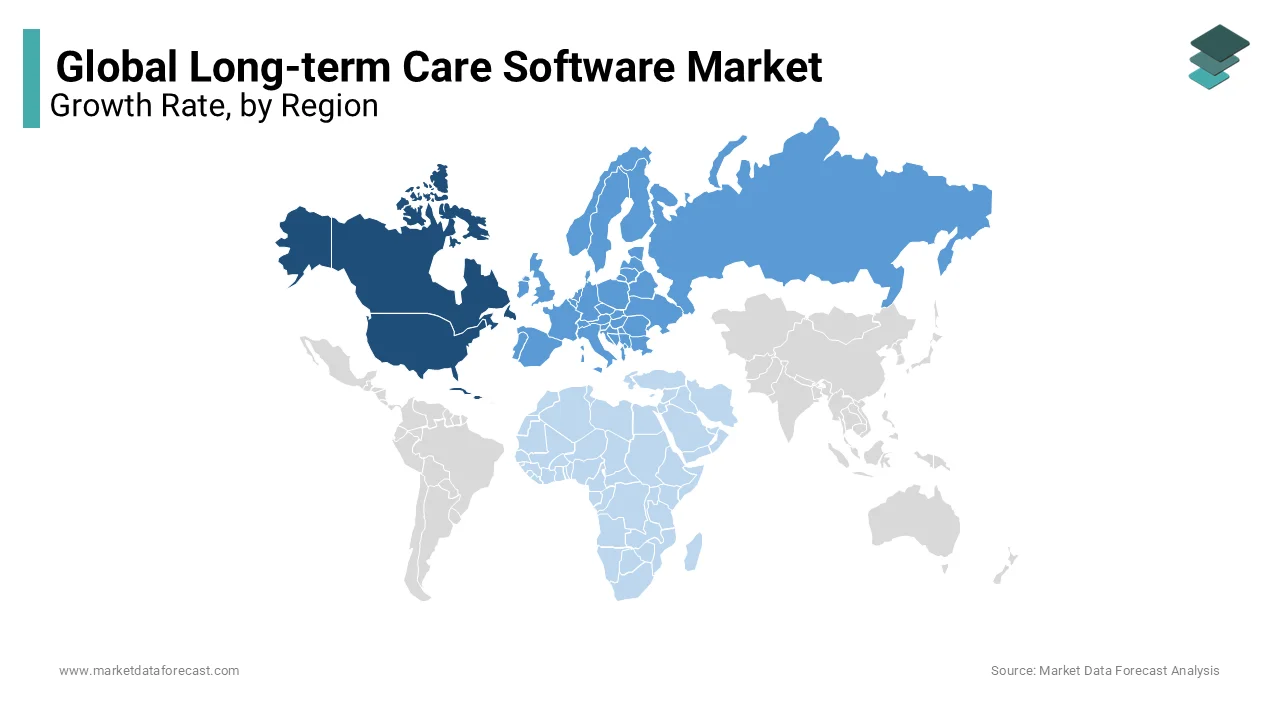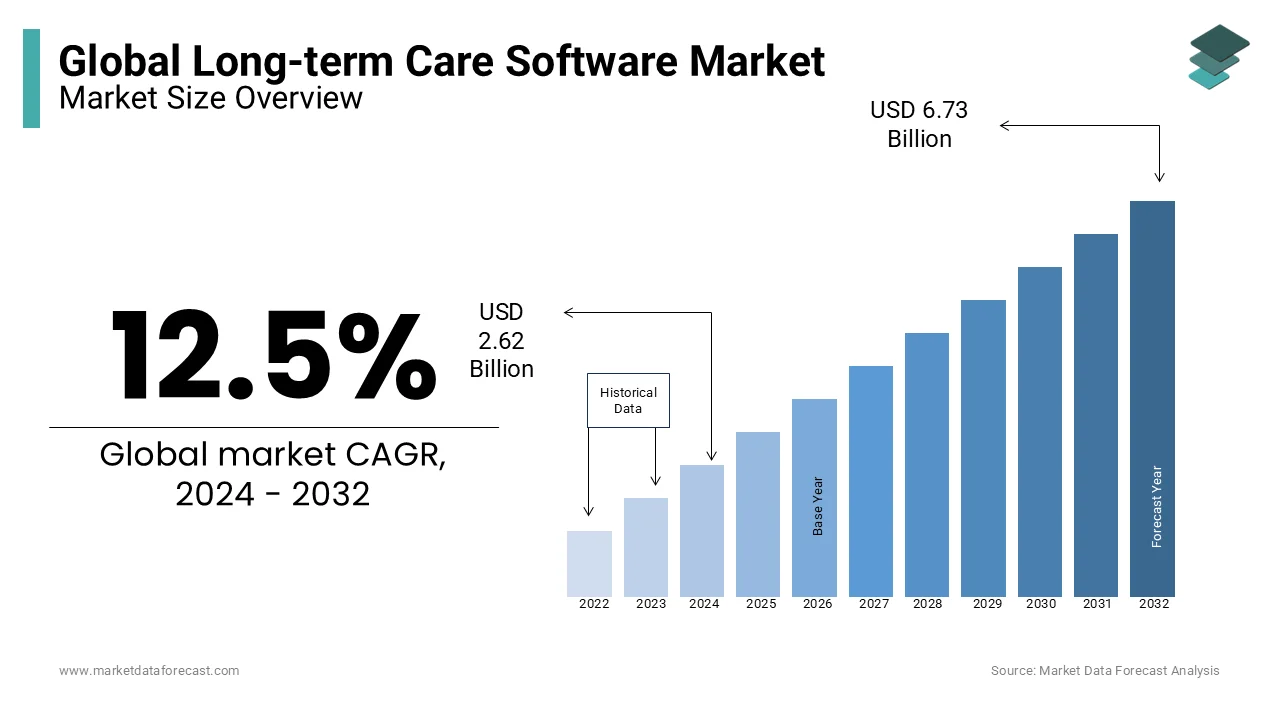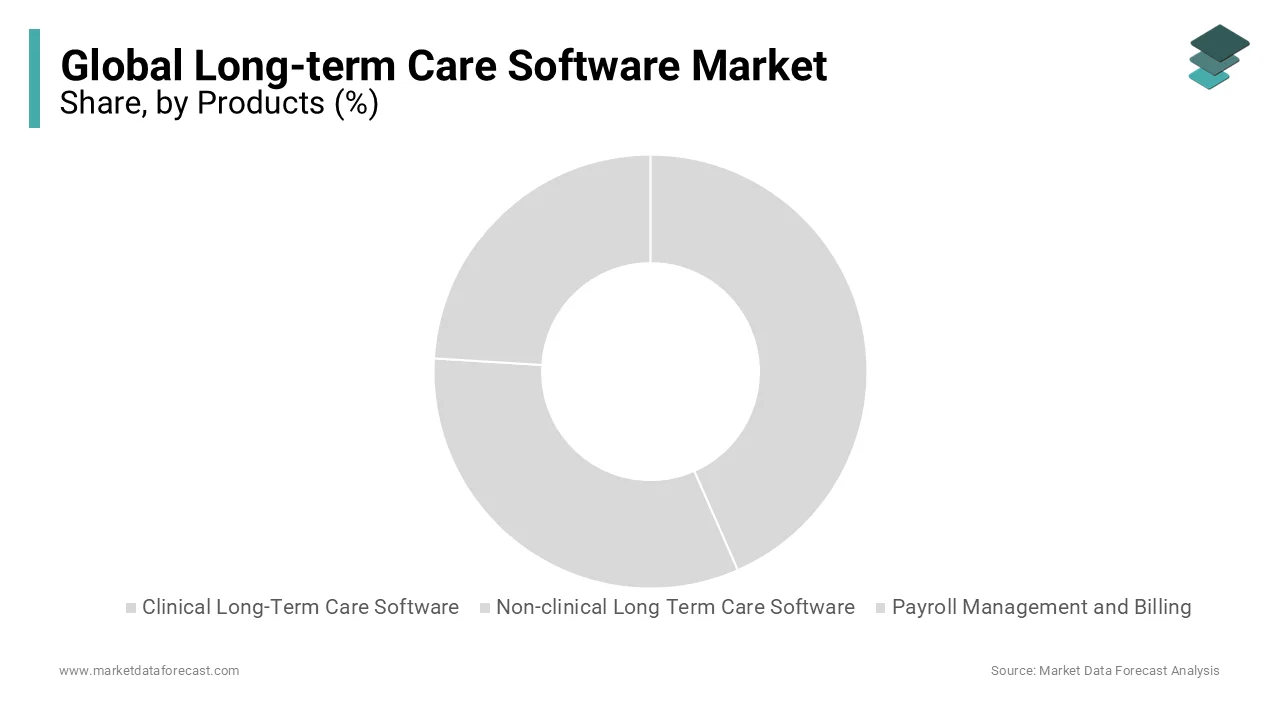Global Long-term Care Software Market Size, Share, Trends & Growth Forecast Report By Product (Clinical Software, Non-clinical Software), Mode of Delivery, End User and Region (North America, Europe, Asia-Pacific, Latin America, Middle East and Africa), Industry Analysis From 2025 To 2033.
Global Long-term Care Software Market Size
The size of the global long-term care software market was worth USD 2.62 billion in 2024. The global market is anticipated to grow at a CAGR of 12.5% from 2025 to 2033 and be worth USD 7.57 billion by 2033 from USD 2.95 billion in 2025.
Long-term care is a clinical service that helps the medical and non-medical needs of people with a disability or chronic diseases who cannot care for themselves. It is concentrated on individualized and coordinated services that give the patient independence and quality of life and provide services to patient needs from time to time. Long-term care levels include day programs, home care, nursing homes, senior housing, continuing care retirement communities, and assisted living. The long-term software is fully integrated with electronic health records and other non-clinical solutions to increase patient care, decrease labor costs, and maintain compliance. Data is entered into the software, which programs and flows through the system for various facilities. It helps provide consolidated reports for multiple facilities, offers good quality care with accurate information, saves time, automatic inter-facility accounting, boosts efficiency and productivity, maintains records over long periods, and reduces the risk of redundancy, eliminating inconsistencies in the documentation.
MARKET DRIVERS
Aging Population and Rising Chronic Diseases Propel Long-term Care Software Market
The growing aging population worldwide, the rising prevalence of chronic diseases, the shortage of skilled nursing personnel, and the rise in disposable income propel the global long-term care software market growth. The aging population across the world is anticipated to hit 1.4 billion by 2030, according to the World Health Organization (WHO). Approximately 12% of the U.S. adult population lives with more than 5+ chronic conditions, 28% with 3+ conditions, and 59% with at least one condition of chronic diseases. In addition, healthcare reforms and government initiatives, the increasing need to reduce healthcare costs, a growing need to raise awareness about diseases, improving healthcare infrastructure, changing demographic trends, and rising government funding are further expected to fuel the long-term care software market expansion.
Need for Monitoring and Care Facilities Boosts Market Demand
Population trends, a lack of healthcare specialists, and numerous government programs worldwide to reduce medical expenditures are other factors expected to accelerate the market's growth rate. To control and monitor such a large proportion of the elderly population susceptible to any chronic condition at any time, even if the disease has only occurred once, it is critical to have them monitored at-home care, nursing facilities, community centers, and assisted living facilities. Therefore, the need for software and equipment to connect to these centers and patients becomes a requirement and thus serves as one of the market's primary drivers.
EHR Adoption and Technological Innovations Drive Market Growth
Based on the current lockdown situation in some countries owing to the outbreak of COVID-19, the usage of EHR systems is expected to aid in monitoring and treating diseases in people who require regular consultations with doctors to check their health state. EHRs (Electronic Health Records) are highly beneficial in medical document management, quality, and health outcomes. The increase in productivity in the healthcare center was noticed for two years. Increasing governmental and private financial incentives for EHR adoption propels the whole EHR market forward while benefiting long-term care EHR solutions positively. Additionally, the rising innovations in the field of long-term care software to add beneficial features and advanced care and the investments from key market-established companies are also supporting the market's rise.
MARKET RESTRAINTS
High Costs, Low Awareness, and Reluctance Hinder LTC Software Market Growth
Lack of awareness of the long-term care software and high costs associated with the maintenance of the software are majorly hindering the global market growth. The reluctance of conventional LTC providers to adopt software and insufficient government initiatives in developing countries are restraining the growth of the long-term care software market. Increased software maintenance costs and the rising reluctance of traditional long-term care providers to adopt software are the major factors that are expected to hinder market growth. In contrast, lower adoption of long-term care software in developing countries is further anticipated to challenge the market's growth in the forecast period.
REPORT COVERAGE
|
REPORT METRIC |
DETAILS |
|
Market Size Available |
2024 to 2033 |
|
Base Year |
2024 |
|
Forecast Period |
2025 to 2033 |
|
CAGR |
12.5% |
|
Segments Covered |
By Product, Mode of Delivery, End-User, and Region. |
|
Various Analyses Covered |
Global, Regional, and country-level analysis; Segment-Level Analysis, DROC; PESTLE Analysis; Porter’s Five Forces Analysis, Competitive Landscape; Analyst Overview of Investment Opportunities |
|
Regions Covered |
North America, Europe, APAC, Latin America, Middle East & Africa |
|
Market Leaders Profiled |
AOD Software, Cerner Corporation, Allscripts Healthcare Solutions, Inc., McKesson Corporation, Omnicare, Inc., Omnicell, Inc., Kronos incorporated, HealthMEDX, PointClickCare, Matrix Care, Sigma Care, and Optimus EMR., and Others. |
SEGMENTAL ANALYSIS
By Product Insights
Based on the product, the e-prescribing segment is anticipated to show a healthy CAGR during the forecast period. Electronic prescription is a new way of entering prescription information into a computer or mobile application and transferring it to pharmacies where it can be dispensed. E-prescribing helps healthcare providers monitor prescription processing, warn patients about allergies, track prescriptions of controlled substances, increase medication adherence, etc. E-prescribing's advantages over other traditional methods contribute to the software market's growth for long-term care.
Furthermore, the EMR (electronic medical records) segment is also expected to show significant growth during the forecast period owing to the growing shift of healthcare sectors toward IT services and the computational maintenance of the patient's health history. In addition, it records to avoid mistakes and loss of records, making it easier to find and maintain thousands of records simultaneously.
By Mode of Delivery Insights
The cloud-based segment is anticipated to grow with the fastest CAGR throughout the forecast period. Remote monitoring of patients and cloud-based software will help create opportunities for the worldwide market for long-term care technology. In addition, global long-term care software market trends are growing demand for cloud-based solutions, partnerships and collaborations, and new product launches.
Additionally, the web-based segment is also expected to grow with a fast CAGR behind cloud systems due to the growing use of online platforms for the convenience of services by consumers. Furthermore, the web is a broader network than a cloud and is easily accessible to populations leading to the segment's growth.
By End-User Insights
The home healthcare segment is expected to dominate the market during the forecast period due to a rise in personalized care and people preferring to stay at home and receive care rather than at hospitals. The advent of the healthcare IT sector has made this practice even more prevalent. Remote care services from hospitals are now being monitored using wearable healthcare devices and the long-term care software associated with them.
However, assisted living facilities are also growing due to the rise in geriatric populations and chronic diseases, leading to more patient enrolments. In addition, the growing stressful lifestyles of the younger generations to make ends meet is forcing them to opt for an outside care facility leading to segment expansion.
REGIONAL ANALYSIS

The North American region held a significant global market share in 2024. The presence of significant players in the region and the expanding acceptance of long-term care software are attributed to the region's rapid growth. In 2024, the United States led the North American long-term care software market. This is owing to a high adoption rate of new technological software services across the country. For instance, the Drug Enforcement Administration (DEA) has allowed doctors to prescribe restricted narcotics electronically. This reduces prescription errors caused by illegible handwritten prescriptions. In addition, various organizations in North America are conducting, supporting, and funding R&D on the health and well-being of the aged. Due to the growing senior population and the desire to reduce healthcare expenses in the region, North America dominates the global market for long-term care software.
Due to rapid expansion in the healthcare sector and significant adoption of web-based and cloud-based long-term care software in emerging nations, the Asia-Pacific long-term care software market and Europe long-term care software market are likely to account for a considerable share of the global market. As a result, the Asian market is predicted to grow rapidly in the next five years, with China and India being the fastest-rising markets in this region. Europe accounted for around 18.2% of the global market share in 2024 and is anticipated to register promising growth during the forecast period owing to the growing adoption of technological advancements and improving healthcare infrastructure.
The long-term care software market in Latin America is gaining attention in this region and is anticipated to register steady growth during the forecast period. The aging population ratio has increased from 5% to 9% from 1990 to 2019 in the Latin America and Caribbean regions. Therefore, long-term care software usage will increase among the aging population. The growing aging population in Latin America is anticipated to boost the demand and market growth for long-term care software during the forecast period. An estimated 8 million people in Latin America and the Caribbean need long-term care to do basic things.
The long-term care software market in the Middle East and Africa is expected to grow at a moderate CAGR during the forecast period. The Middle East and Africa have seen a spike in the number of people affected with Alzheimer's recently. According to the World Health Organization (WHO), an estimated 125% of growth will be there in Alzheimer's patients in MENA countries by 2050. The risk of diagnosing with Alzheimer's increases when a person turns 65 years of age. The growing aging population and an increasing number of patients with Alzheimer's in this region are propelling the market growth.
KEY MARKET PLAYERS
Some of the notable companies leading the global long-term care software market profiled in the report are AOD Software, Cerner Corporation, Allscripts Healthcare Solutions, Inc., McKesson Corporation, Omnicare, Inc., Omnicell, Inc., Kronos incorporated, HealthMEDX, PointClickCare, Matrix Care, Sigma Care, Optimus EMR, and Others.
RECENT HAPPENINGS IN THE MARKET
- In November 2022, Tork introduced two no-cost online training options to fulfill the higher standards for cleanliness. This cutting-edge teaching application offers an excellent interactive learning environment for better results and behavioral change, raising cleanliness and health standards in long-term care facilities. This result has been driven by a desire among workers in long-term care homes for better training in hand hygiene and cleaning techniques.
- In October 2022, Oracle, a firm well-known for its database software history, acquired Cerner to expand into the healthcare sector. However, after purchasing Cerner, the software giant Oracle Corp. is shutting several of the health records company's operations in Kansas City and consolidating employees in one place. The corporation, a significant employer in Kansas City, was selling off office space as it shifted to a hybrid workforce before Oracle finalized its $28.3 billion business acquisition in June.
- In November 2022, ColdQuanta, the leader in the global quantum ecosystem, today revealed a $110 million Series B round of investment for the company's product portfolio, including atomic clocks, sensors, components, quantum computing, quantum algorithms, and applications. The underlying technology of ColdQuanta has several uses across the spectrum of quantum technology. For example, along with creating the next generation of radio frequency (RF) technologies and atomic clocks, which provide considerable benefits over conventional antenna-based receivers, they are also working on quantum technology.
- In November 2022, Massachusetts Business Magazine stated that A new fund called VCF at Hula had been established by a partnership between Vermont Community Foundation (VCF) and The Fund at Hula. This venture capital company invests in seed and early-stage technological start-ups. This partnership brings together two organizations dedicated to promoting community and economic development in the state. The charity funds that join VCF at Hula get investment returns that increase their capacity to provide grants in the future and have a bigger positive influence on the community.
MARKET SEGMENTATION
This research report on the global long-term care software market has been segmented based on the product, Mode of delivery, end-user, and region.
By Product
- Clinical Long-Term Care Software
- EMR/HER
- e-Prescribing
- Electronic Medication Administration Records
- Clinical Decision Support Systems
- Non-clinical Long Term Care Software
- Payroll Management and Billing
- Remote Patient Monitoring Systems
- Real-Time Location Systems
- Remote Training and Supervision Systems
- Invoicing And Scheduling Software
By Mode of Delivery
- Cloud-based
- Web-based
- On-premises
By End-user
- Home Healthcare
- Nursing care
- Assisted Living Facilities
By Region
- North America
- Europe
- Asia Pacific
- Latin America
- Middle East and Africa
Frequently Asked Questions
What are the propelling growth for long term care software market?
Apparently, the APAC region is anticipated to showcase the fastest CAGR in the worldwide market.
Which region is growing the fastest in the global long term care software market?
AOD Software, Cerner Corporation, Allscripts Healthcare Solutions, Inc., McKesson Corporation, Omnicare, Inc., Omnicell, Inc., Kronos incorporated, HealthMEDX, PointClickCare, Matrix Care, Sigma Care, and Optimus EMR are a few of the notable players in the long-term care software market.
Who are the prominent players in the long term care software market?
The global long-term care software market size was valued at USD 2.62 billion in 2024.
Related Reports
Access the study in MULTIPLE FORMATS
Purchase options starting from
$ 2500
Didn’t find what you’re looking for?
TALK TO OUR ANALYST TEAM
Need something within your budget?
NO WORRIES! WE GOT YOU COVERED!
Call us on: +1 888 702 9696 (U.S Toll Free)
Write to us: sales@marketdataforecast.com


